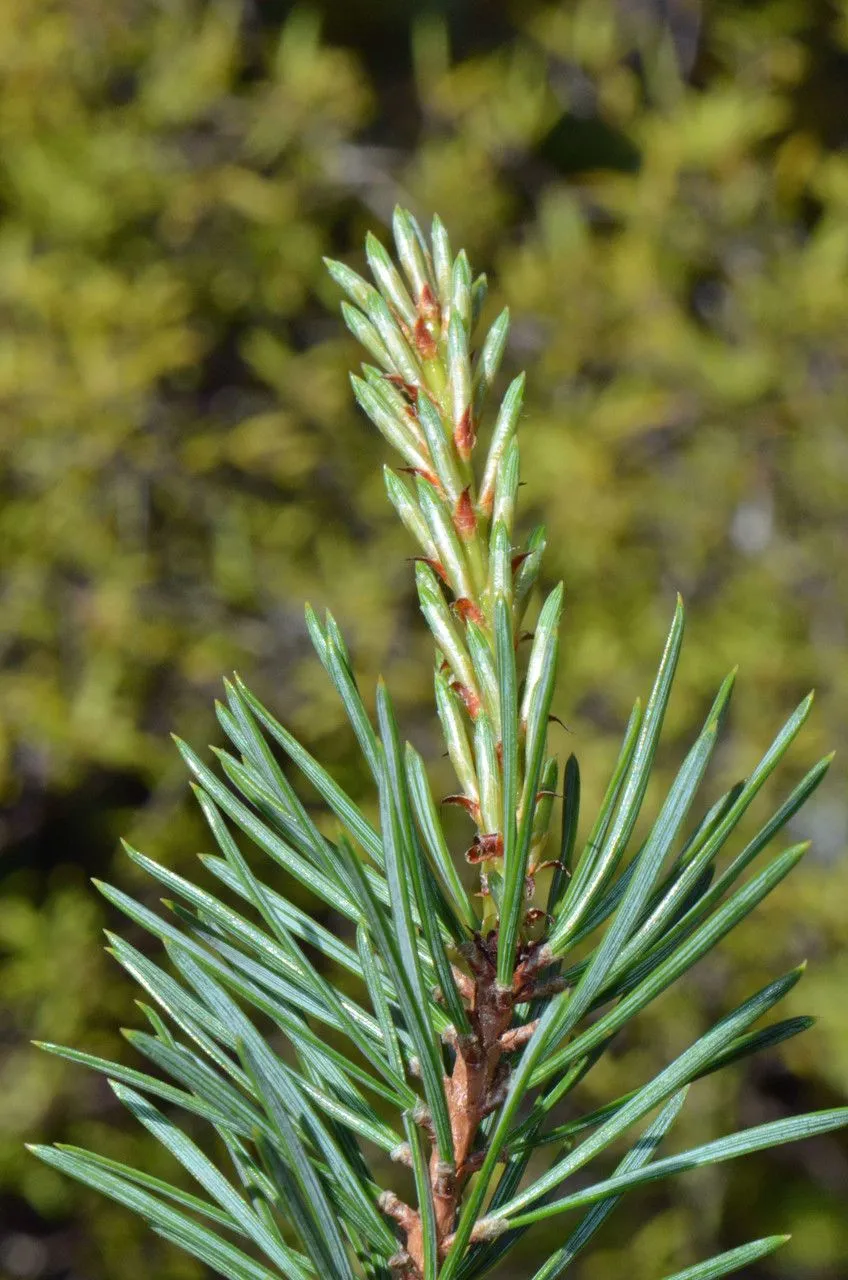
Author: Douglas ex Loudon
Bibliography: Arbor. Frutic. Brit. 4: 2292 (1838)
Year: 1838
Status: accepted
Rank: species
Genus: Pinus
Vegetable: False
Observations: Subarctic America to Mexico (N. Baja California)
The Lodgepole pine, scientifically known as Pinus contorta, is a remarkable species within the diverse family of Pinaceae. This resilient tree commands a significant presence across a vast geographic range that spans from the subarctic regions of North America down to northern Baja California in Mexico.
The species was first detailed in botanical literature in the seminal work Arboretum et Fruticetum Britannicum in 1838, chronicled by botanist David Douglas and noted by Loudon. The description in this text marked an important moment in the scientific documentation of North American flora, cementing the Lodgepole pine’s place in botany.
Pinus contorta is renowned for its ability to thrive in various environmental conditions, from wind-swept coastal regions to alpine and subalpine forests. It is a versatile and sturdy tree, often characterized by its slender, straight trunk and its distinctive, sometimes twisting, growth pattern that gives rise to its scientific name, ‘contorta’. This tree’s adaptability to diverse climates makes it a keystone species in many ecosystems, playing a crucial role in maintaining the ecological balance.
Ecologically, the Lodgepole pine provides numerous benefits, including shelter and food for wildlife. Its seeds are a valuable source of nutrition for birds and small mammals, while its dense foliage offers protection against harsh weather conditions. Furthermore, the Lodgepole pine has a unique relationship with forest fires; its serotinous cones require the intense heat of a fire to open and release seeds, thereby ensuring the regeneration of the forest.
In addition to its ecological significance, the Lodgepole pine has been historically exploited for various human uses. Indigenous peoples of North America utilized its straight trunks for constructing lodges and other structures, from which the common name “Lodgepole” is derived. Today, it continues to be valued for timber and paper production.
Understanding the Lodgepole pine’s adaptability and resilience offers key insights into sustainable forest management and conservation practices. It stands as a testament to the intricate and enduring relationship between natural species and their environments across a broad latitudinal gradient.
Dan: almindelig vintergæk, contorta-fyr, klit-fyr
Swe: contortatall, ramslök, sandlök, skogslök, snödroppe, kontortamänty, klipptall
Hun: csavarttus fenyo
Deu: dreh-kiefer, drehkiefer
Eng: lodgepole pine, shore pine, tamarack pine, contorta pine, scrub pine, twisted pine, bolander beach pine, bolander’s beach pine
Fin: lumikello, kontortamänty
Fra: pin, pin de murray, pin lodgepole, pin tordu, pin tortillé
Ita: pino contorto
Nor: snøklokke, vrifuru
Ces: borovice pokroucená
Nob: vrifuru
Nno: vrifuru
Nld: draaiden
Cym: pinwydden gamfrig
En: Lodgepole pine, Contorta pine, Twisted pine, Bolander Beach Pine, Bolander’s Beach Pine, Hoóxe’e, Shore Pine, Tamarack Pine, Scrub pine
Zh: 美国黑松
Cs: Borovice pokroucená
Da: Klitfyr, Almindelig Vintergæk, Contorta-fyr, Klit-fyr
Nl: Draaiden
Et: Keerdmänd
Fi: Kontortamänty, Lumikello
Fr: Pin tordu, Pin, Pin de Murray, Pin lodgepole, Pin tortillé
De: Drehkiefer, Küsten-Kiefer, Dreh-Kiefer
He: אורן מפותל
Hu: Csavarttűjű fenyő, Csavarttus fenyo
Is: Stafafura
It: Pino contorto
Ja: Kontoruta-matsu
Lt: Suktaspyglė pušis
No: Vrifuru, Snøklokke
Nb: Vrifuru
Nn: Vrifuru
Fa: کاج ساحلی
Pl: Sosna wydmowa
Ru: Сосна скрученная широкохвойная
Sk: Borovica stočená
Sv: Contortatall, Ramslök, Sandlök, Skogslök, Snödroppe, Kontortamänty, Klipptall
Zh-hant: 扭葉鬆
Uk: Сосна скручена широкохвойна
Cy: Pinwydden gamfrig
Taken Nov 22, 2009 by EOL − Tamara Horová (cc-by-nc)
Taken Oct 16, 1998 by EOL − Charles Webber (cc-by-nc-sa)
Taken Aug 1, 2005 by EOL − Steven J. Baskauf (cc-by-nc-sa)
Taken Sep 8, 2015 by EOL − Zoya Akulova (cc-by-nc)
Taken Jan 18, 2014 by EOL − Wendy Feltham (cc-by-nc)
Taken Dec 6, 2015 by EOL − Pat Enright (cc-by-nc)
Taken Jan 1, 1900 by EOL − Iwona Erskine-Kellie from Vancouver, Canada (cc-by)
Taken Aug 1, 2010 by herve rey (cc-by-sa)
Taken Dec 31, 2015 by EOL − JK Johnson (cc-by-nc)
Taken Feb 16, 2022 by Jeremiah Pruitt (cc-by-sa)
Taken Jul 6, 2007 by EOL − Steven J. Baskauf (cc-by-nc-sa)
Taken May 23, 2021 by Vicky Ma (cc-by-sa)
Taken May 23, 2021 by Vicky Ma (cc-by-sa)
Taken May 29, 2015 by EOL − paloma (cc-by-nc)
Taken Jan 1, 1900 by EOL − Crusier (cc-by-sa)
Taken Sep 9, 2019 by Ghislave Sosnowski (cc-by-sa)
Taken Feb 16, 2022 by Jeremiah Pruitt (cc-by-sa)
Taken Aug 9, 2020 by Ben Jennings (cc-by-sa)
Taken Nov 7, 2022 by Anibal Oberländer (cc-by-sa)
Taken Jun 24, 2020 by k c (cc-by-sa)
Taken Jul 10, 2014 by EOL − Gary Griffith (cc-by-nc-sa)
Taken Jul 10, 2014 by EOL − Gary Griffith (cc-by-nc-sa)
Taken Jun 5, 2014 by EOL − Royal Tyler (cc-by-nc-sa)
Taken Jun 20, 2014 by EOL − paloma (cc-by-nc)
Taken Sep 6, 2019 by Karen Pease (cc-by-sa)
© copyright of the Board of Trustees of the Royal Botanic Gardens, Kew.
© copyright of the Board of Trustees of the Royal Botanic Gardens, Kew.
Taken Oct 15, 1998 by EOL − Charles Webber (cc-by-nc-sa)
Growth form: Single Stem
Growth habit: Tree
Growth rate: Rapid
Ph maximum: 7.5
Ph minimum: 6.2
Light: 7
Atmospheric humidity: 6
Soil nutriments: 4
Family: Myrtaceae Author: (F.Muell.) K.D.Hill & L.A.S.Johnson Bibliography: Telopea 6: 402 (1995) Year: 1995 Status:…
Family: Rubiaceae Author: Pierre ex A.Froehner Bibliography: Notizbl. Bot. Gart. Berlin-Dahlem 1: 237 (1897) Year:…
Family: Sapindaceae Author: Koidz. Bibliography: J. Coll. Sci. Imp. Univ. Tokyo 32(1): 38 (1911) Year:…
Family: Asteraceae Author: A.Gray Bibliography: Pacif. Railr. Rep.: 107 (1857) Year: 1857 Status: accepted Rank:…
Family: Fabaceae Author: Medik. Bibliography: Vorles. Churpfälz. Phys.-Ökon. Ges. 2: 398 (1787) Year: 1787 Status:…
Family: Aspleniaceae Author: (Cav.) Alston Bibliography: Bull. Misc. Inform. Kew 1932: 309 (1932) Year: 1932…